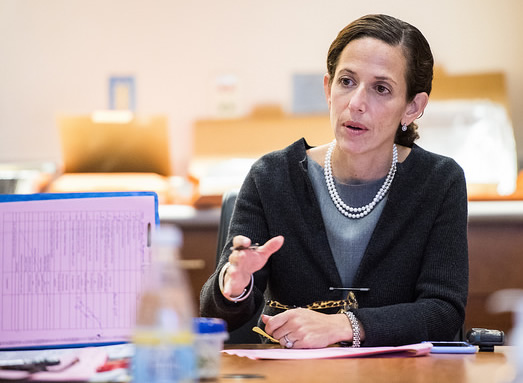Gaming Cells to Turn Off the Metastases Switch in Breast Cancer
Author: Rosemary Clandos Media contact: Nicole Fawcett, 734-764-2220 | Patients may contact Cancer AnswerLine™, 800-865-1125
Cancer progression can be spurred by TGF-beta pathway signaling, and Michigan Medicine researchers have found a way to stop the signal from turning green.

It’s like a board game designed for some serious scientists: Switch Land.
The characters are Wicked TNBC, Tricky TGF-beta, Expressive Cyclins, Queen SMAD3, Sassy CDK2 and Prissy Pin1. The players take turns rolling the dice to move along a signaling pathway. The goal is to avoid the mutation mud, steer clear of the polluted phosphorylation pit, don’t stop in the interaction zone and ultimately take Tricky TGF-beta to the showers of CDK inhibitors.
But only one of several CDK inhibitor showers will work. To win the game, the player must land on the correct one: the shower with the Rx label CYC065.
Here are the key players in this real-life game to stop cancer progression.
Wicked TNBC
Triple negative breast cancer is an aggressive disease that affects 15 to 20 percent of newly diagnosed breast cancer patients every year. There are many different mutations of TNBC, and their destructive cells move away from the breast to metastasize in the lung, liver, bone and brain.
"There are no targeted therapeutic drugs to treat this type of cancer. So patients receive the treatment that is standard for other types of breast cancer" says Jacqueline S. Jeruss, M.D., Ph.D., director of the Breast Care Center at the University of Michigan Rogel Cancer Center and associate professor of surgery at Michigan Medicine.
"However, we know the treatment will likely result in suboptimal or less favorable outcomes. That’s the biggest challenge with the research," says Jeruss, senior author of the paper published in the journal Cell Cycle.
Tricky TGF-beta
Transforming growth factor beta is a turncoat ligand. In the early stages of cancer tumors, TGF-beta blocks tumor cell growth. It’s suppressive. But in the later stages, TGF-beta promotes tumor growth and metastasis.
"Our work is unique because we’re looking into the biological switch that causes TGF-beta to change from preventing tumors to promoting tumors,"says Alexandra L. Thomas, the first author of the paper. She is a doctoral candidate through Northwestern University who is finishing her work in the Jeruss Lab.
Some cells release TGF-beta and other cells grab the TGF-beta. This action creates a cell-to-cell path, known as a TGF-beta signaling pathway.
"This signaling pathway within cells acts differently with different cancers. So in our study, it was important to understand how it works specifically with TNBC," says Thomas.
Next, in the mutation mud, cells divide and mutation occurs.
"Cancer hijacks and manipulates the pathways that are in normal cells. Generally, random mutations occur as cancer cells divide. When you get mutations, then you start to see the deregulation of signaling pathways,"” says Thomas.
Expressive cyclins
Some patients with TNBC have tumors that over-express a type of protein called cyclins. These cyclins are associated with the cycle of cell division. One cyclin in particular, cyclin E, triggers activity with an enzyme called CDK2, which can become dangerously hyperactive, says Thomas.
This hyperactivity can increase the likelihood of more cancer mutations and deregulation of additional signaling pathways.
Queen SMAD3, Sassy CDK2 and Prissy Pin1
When SMAD3 stops working properly, it causes the TGF-beta to stop working properly.
In our imaginary game, Sassy CDK2 has a little interaction with Queen SMAD3. As a result, the Queen SMAD3 phosphorylates in a wild way. This phosphorylation causes the turncoat behavior of Tricky TGF-beta. (Jealously, perhaps.) Then, Tricky TGF-beta stops protecting patients from tumor cell growth, and it begins to promote cancer growth.
The intrigue goes further. Pin1, an isomerase, knows a phosphorylated SMAD3 when it sees one, so it binds to the SMAD3. Researchers have found that Pin1 is over-expressed in breast cancers and other cancers, and it increases the likelihood of poor outcomes for patients.
Queen SMAD3 settles down
To win the game, this process has to be nipped in the bud.
"To stop the Pin1 from interacting with SMAD3, we used a CDK inhibitor called CYC065. Then the noncanonical phosphorylation of SMAD3 was blocked," says Thomas. "This blockage restored the proper TGF-beta signaling."
"We also found that the inhibitor caused the SMAD3 protein levels to stabilize. This suggests that the unusual phosphorylation signals other proteins to degrade SMAD3. That’s why you get the switch from tumor-suppressive to tumor-promoting behavior," says Thomas.
Winning the game
In essence, the researchers recently learned how to win the game when they took Sassy CDK2 to a shower of CYC065, which blocked:
- The bad phosphorylation of SMAD
- The interaction of SMAD3 and Pin1
- SMAD3 from being degraded
- TNBC cells from migrating and invading
Plus, there was a bonus play. Researchers found that when they depleted Pin1, a similar reaction occurred: TNBC cells stopped migration and invasion.
In the study, the scientists tested the inhibitor on three cell lines. All of them had the same positive outcomes. In vitro models were used for the treatment with the CDK inhibitor. For the migration and invasion experiments, the researchers used in vitro models of cancer metastases.
More Switch Land to come
Research with CDK inhibitors has taken off in recent years. "“There are many inhibitors under research, but only one is approved by the FDA. We’re getting better at finding the right inhibitor that works best for whatever cancer you’re looking at," says Thomas. "As research progresses, we’re confident there will be more positive results."
